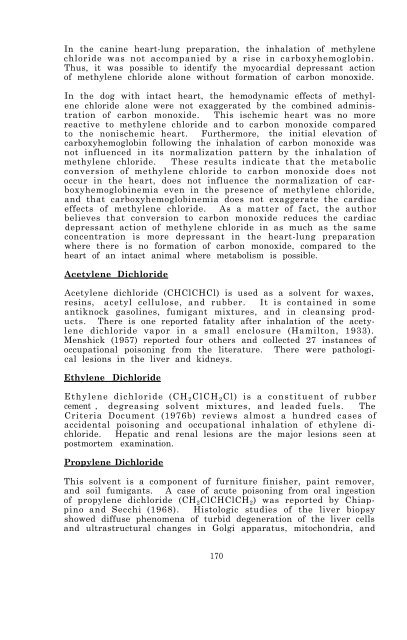Review of Inhalants - ARCHIVES - National Institute on Drug Abuse
Review of Inhalants - ARCHIVES - National Institute on Drug Abuse
Review of Inhalants - ARCHIVES - National Institute on Drug Abuse
Create successful ePaper yourself
Turn your PDF publications into a flip-book with our unique Google optimized e-Paper software.
In the canine heart-lung preparati<strong>on</strong>, the inhalati<strong>on</strong> <str<strong>on</strong>g>of</str<strong>on</strong>g> methylene<br />
chloride was not accompanied by a rise in carboxyhemoglobin.<br />
Thus, it was possible to identify the myocardial depressant acti<strong>on</strong><br />
<str<strong>on</strong>g>of</str<strong>on</strong>g> methylene chloride al<strong>on</strong>e without formati<strong>on</strong> <str<strong>on</strong>g>of</str<strong>on</strong>g> carb<strong>on</strong> m<strong>on</strong>oxide.<br />
In the dog with intact heart, the hemodynamic effects <str<strong>on</strong>g>of</str<strong>on</strong>g> methylene<br />
chloride al<strong>on</strong>e were not exaggerated by the combined administrati<strong>on</strong><br />
<str<strong>on</strong>g>of</str<strong>on</strong>g> carb<strong>on</strong> m<strong>on</strong>oxide. This ischemic heart was no more<br />
reactive to methylene chloride and to carb<strong>on</strong> m<strong>on</strong>oxide compared<br />
to the n<strong>on</strong>ischemic heart. Furthermore, the initial elevati<strong>on</strong> <str<strong>on</strong>g>of</str<strong>on</strong>g><br />
carboxyhemoglobin following the inhalati<strong>on</strong> <str<strong>on</strong>g>of</str<strong>on</strong>g> carb<strong>on</strong> m<strong>on</strong>oxide was<br />
not influenced in its normalizati<strong>on</strong> pattern by the inhalati<strong>on</strong> <str<strong>on</strong>g>of</str<strong>on</strong>g><br />
methylene chloride. These results indicate that the metabolic<br />
c<strong>on</strong>versi<strong>on</strong> <str<strong>on</strong>g>of</str<strong>on</strong>g> methylene chloride to carb<strong>on</strong> m<strong>on</strong>oxide does not<br />
occur in the heart, does not influence the normalizati<strong>on</strong> <str<strong>on</strong>g>of</str<strong>on</strong>g> carboxyhemoglobinemia<br />
even in the presence <str<strong>on</strong>g>of</str<strong>on</strong>g> methylene chloride,<br />
and that carboxyhemoglobinemia does not exaggerate the cardiac<br />
effects <str<strong>on</strong>g>of</str<strong>on</strong>g> methylene chloride. As a matter <str<strong>on</strong>g>of</str<strong>on</strong>g> fact, the author<br />
believes that c<strong>on</strong>versi<strong>on</strong> to carb<strong>on</strong> m<strong>on</strong>oxide reduces the cardiac<br />
depressant acti<strong>on</strong> <str<strong>on</strong>g>of</str<strong>on</strong>g> methylene chloride in as much as the same<br />
c<strong>on</strong>centrati<strong>on</strong> is more depressant in the heart-lung preparati<strong>on</strong><br />
where there is no formati<strong>on</strong> <str<strong>on</strong>g>of</str<strong>on</strong>g> carb<strong>on</strong> m<strong>on</strong>oxide, compared to the<br />
heart <str<strong>on</strong>g>of</str<strong>on</strong>g> an intact animal where metabolism is possible.<br />
Acetylene Dichloride<br />
Acetylene dichloride (CHClCHCl) is used as a solvent for waxes,<br />
resins, acetyl cellulose, and rubber. It is c<strong>on</strong>tained in some<br />
antiknock gasolines, fumigant mixtures, and in cleansing products.<br />
There is <strong>on</strong>e reported fatality after inhalati<strong>on</strong> <str<strong>on</strong>g>of</str<strong>on</strong>g> the acetylene<br />
dichloride vapor in a small enclosure (Hamilt<strong>on</strong>, 1933).<br />
Menshick (1957) reported four others and collected 27 instances <str<strong>on</strong>g>of</str<strong>on</strong>g><br />
occupati<strong>on</strong>al pois<strong>on</strong>ing from the literature. There were pathological<br />
lesi<strong>on</strong>s in the liver and kidneys.<br />
Ethylene Dichloride<br />
Ethylene dichloride (CH 2ClCH 2Cl) is a c<strong>on</strong>stituent <str<strong>on</strong>g>of</str<strong>on</strong>g> rubber<br />
cement , degreasing solvent mixtures, and leaded fuels. The<br />
Criteria Document (1976b) reviews almost a hundred cases <str<strong>on</strong>g>of</str<strong>on</strong>g><br />
accidental pois<strong>on</strong>ing and occupati<strong>on</strong>al inhalati<strong>on</strong> <str<strong>on</strong>g>of</str<strong>on</strong>g> ethylene dichloride.<br />
Hepatic and renal lesi<strong>on</strong>s are the major lesi<strong>on</strong>s seen at<br />
postmortem examinati<strong>on</strong>.<br />
Propylene Dichloride<br />
This solvent is a comp<strong>on</strong>ent <str<strong>on</strong>g>of</str<strong>on</strong>g> furniture finisher, paint remover,<br />
and soil fumigants. A case <str<strong>on</strong>g>of</str<strong>on</strong>g> acute pois<strong>on</strong>ing from oral ingesti<strong>on</strong><br />
<str<strong>on</strong>g>of</str<strong>on</strong>g> propylene dichloride (CH 2ClCHClCH 2) was reported by Chiappino<br />
and Secchi (1968). Histologic studies <str<strong>on</strong>g>of</str<strong>on</strong>g> the liver biopsy<br />
showed diffuse phenomena <str<strong>on</strong>g>of</str<strong>on</strong>g> turbid degenerati<strong>on</strong> <str<strong>on</strong>g>of</str<strong>on</strong>g> the liver cells<br />
and ultrastructural changes in Golgi apparatus, mitoch<strong>on</strong>dria, and<br />
170
















